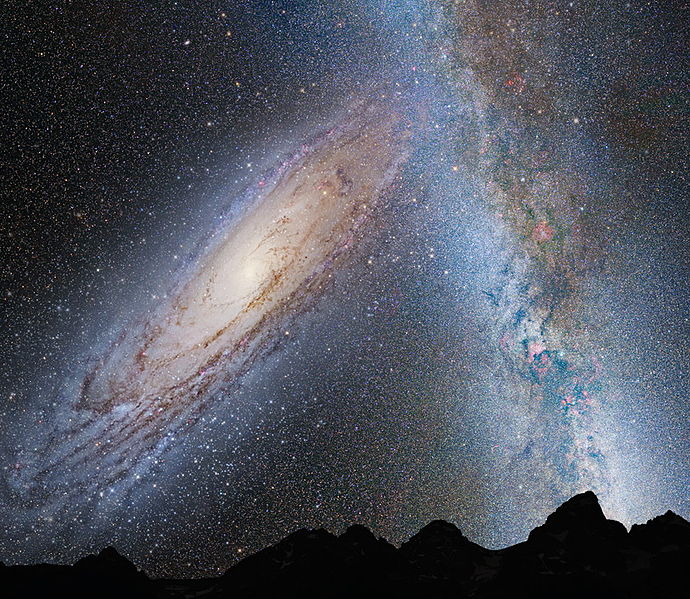Станаўленне нашага дома галактыка Milky Way began 12 billion years ago. Since then, it has undergone a sequence of mergers with other galaxies and grew in mass and size. The remnants of building blocks (i.e., galaxies that merged with the Miky Way in the past) can be identified through their unusual values for energy and angular momentum and low metallicity. The two earliest building blocks of our home галактыка have recently been identified using Gaia dataset and have been named Shiva and Shakti after Hindu deities. Gaia прастору telescope which is dedicated to the study of our home galaxy has revolutionised the study of Milky Way. Gaia Enceladus/ Sausage stream, the Pontus stream and the “poor old heart” of the Milky Way were identified earlier using Gaia dataset. The history of Milky Way is replete with mergers. Купіна Прастора Telescope images suggest that six billion years from now, our home galaxy will merge with the neighbouring Andromeda galaxy.
Галактыкі і іншыя буйныя структуры ўтварыліся ў сусвет прыкладна праз 500 мільёнаў гадоў пасля Вялікага выбуху.
Станаўленне нашага дома галактыка Млечны Шлях пачаўся каля 12 мільярдаў гадоў таму. З тых часоў яна зведала шэраг зліццяў з іншымі галактыкамі, што спрыяла росту яе масы і памеру. Гісторыя Млечнага Шляху - гэта па сутнасці гісторыя зліцця іншых галактык з нашай роднай галактыкай.
The basic properties of the Лік зорак: like energy and angular momentum are directly linked to the speed and direction of the галактыка of origin and are shared between the stars of the same galaxy. When galaxies merge, energy and angular momentum remain conserved over time. This serves as a key tool in identification of a merger remnant. A large group of Лік зорак: with similar unusual values of energy and angular momentum are likely to be a merger remnant of a galaxy. Also, the older stars have low metallicity, i.e., stars that formed earlier have low metal contents. Based on these two criteria, it is possible to trace merger history of the Milky Way however it would not have been possible without the Gaia datasets.
Launched by ESA on 19 December 2013, Gaia прастору telescope is dedicated to the study of Milky Way including its origin, structure and evolutionary history. Parked in Lissajous арбіта around L2 Lagrange point (located approximately 1.5 million km from Earth in the direction opposite the Sun) along JWST and Euclid spacecrafts, Gaia probe is conducting a huge stellar census covering about 1.5 billion stars in the Milky Way recording their motions, luminosity, temperature and composition and creating a precise 3D map of the home галактыка. Hence, Gaia is also referred as billion-star surveyor. The datasets generated by Gaia has revolutionized study of history Milky Way.
In 2021, using Gaia datasets, astronomers learnt of a major merger and identified Gaia Enceladus/Sausage stream, the remnant of Gaia-Sausage-Enceladus (GSE) галактыка that merged with the Milky Way between 8 and 11 billion years ago. Subsequently, Pontus stream and “poor old heart” of the Milky Way were identified the following year. The Pontus stream is the remnant of Pontus merger while “poor old heart” is зорка group that formed during the initial mergers that created the proto-Milky Way and continue to reside in the central region of Milky Way.
Now, astronomers report discovery of two streams of Лік зорак: that formed and merged with an early version of our Milky Way between 12 and 13 billion years ago, around the time when galaxies were forming in the early Сусвет. Для гэтага даследчыкі аб'ядналі дадзеныя Gaia з падрабязнымі зорнымі спектрамі з Sloan Лічбавы агляд (DR17) and observed that stars were crowded around two specific combinations of energy and angular momentum for a certain range of low-metal stars. The two groups had angular momentum similar to the stars that had been part of separate galaxies which merged with the Milky Way. Perhaps, the earliest building blocks of the Milky Way, the researchers have named them Shiva and Shakti after the Hindu deities. It is possible that the newly discovered star groups were first to merge with the ‘poor old heart’ of our Milky Way and the story towards a large галактыка began. Future studies should confirm if Shiva and Shakti are indeed part of prehistory of Milky Way.
Што будзе з нашай роднай галактыкай у будучыні?
Эвалюцыйная гісторыя Млечнага Шляху багатая зліццямі. Купіна Прастора Telescope images suggests that six billion years from now, our home galaxy will merge with the neighbouring Andromeda galaxy situated at 2.5 million light-years away to give rise to a new galaxy. Andromeda will collide with the Milky Way at 250,000 mph about 4 billion years from now. The clash between the two galaxies will last for 2 billion years giving rise to a combined elliptical galaxy.
The solar system and the Earth will survive but will have new coordinates in прастору.
***
Спасылкі:
- Найду Р.П., і інш 2021. Рэканструкцыя апошняга буйнога зліцця Млечнага Шляху з аглядам H3. Астрафізічны часопіс, том 923, нумар 1. DOI: https://doi.org/10.3847/1538-4357/ac2d2d
- Малхан К., і інш 2022. Глабальны дынамічны атлас зліццяў Млечнага Шляху: абмежаванні ад арбіт шаравых навалаў, зорных патокаў і спадарожнікавых галактык на аснове Gaia EDR3. Апублікавана 17 лютага 2022 г. The Astrophysical Journal, том 926, нумар 2. DOI: https://doi.org/10.3847/1538-4357/ac4d2a
- Малхан К. і Рыкс Х.-В., 2024. «Шыва і Шакці: меркаваныя протагалактычныя фрагменты ва ўнутраным Млечным Шляху. Астрафізічны часопіс. Апублікавана 21 сакавіка 2024 г. DOI: https://doi.org/10.3847/1538-4357/ad1885
- Інстытут астраноміі Макса Планка (MPIA). Навіны – Даследчыкі ідэнтыфікуюць два з самых ранніх будаўнічых блокаў Млечнага Шляху. Даступны па адрасе https://www.mpia.de/news/science/2024-05-shakti-shiva?c=5313826
- Schiavi R. eт інш 2021. Будучае зліццё Млечнага Шляху з галактыкай Андрамеда і лёс іх звышмасіўных чорных дзірак. Прэпрынт у arXiv. DOI: https://doi.org/10.48550/arXiv.2102.10938
***






































